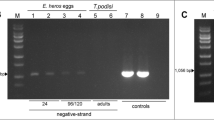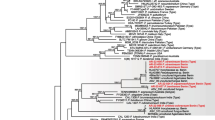Abstract
Nosema pernyi is a lethal pathogen that causes microsporidiosis in the Chinese oak silkworm, Antheraea pernyi. In this study, we presented its morphological and some molecular characteristics. The mature spores were measured to be 4.36 × 1.49 μm. The spore wall consisted of an electron-dense exospore (EX) and electron-lucent endospore (EN) layer. The polar filament (PF) was isofilar with 10–12 coils that were frequently arranged in a single row. Investigation results indicated that N. pernyi can infect the gut wall, silk glands, and other tissues. A full-length SMART cDNA library of N. pernyi was constructed, and then 824 expressed sequence tags (ESTs) were sequenced. Ninety unigenes, out of 197 assembled unigenes, showed significant homology to known genes of Nosema ceranae, Nosema bombycis, Encephalitozoon cuniculi, and other microsporidian species. Based on the nucleotide sequence of the α- and β-tubulin genes and amino acid sequence of actin gene, phylogenetic trees analysis showed that N. pernyi was closely related to Nosema philosamiae and Nosema antheraeae. It was correctly assigned to the Nosema group.




Similar content being viewed by others
References
Bhat SA, Bashir I, Kamili AS (2009) Microsporidiosis of silkworm, Bombyx mori L. (Lepidoptera-Bombycidae): a review. Afr J Agric Res 4:1519–1523
Bhat SA, Nataraju B (2005) A report on the impact of a microsporidian parasite on lamerin breed of the silkworm Bombyx mori L. Int J Ind Entomol 10:143–145
Cheney SA, Lafranchi-Tristem NJ, Bourges D, Canning EU (2001) Relationships of microsporidian genera, with emphasis on the polysporous genera, revealed by sequences of the largest subunit of RNA polymerase II (RPB1). J Eukaryot Microbiol 48(1):111–117
Cornman RS et al (2009) Genomic analyses of the microsporidian Nosema ceranae, an emergent pathogen of honey bees. PLoS Pathog 5(6):e1000466
Corradi N, Gangaeva A, Keeling PJ (2008) Comparative profiling of overlapping transcription in the compacted genomes of microsporidia Antonospora locustae and Encephalitozoon cuniculi. Genomics 91(4):388–393
Didier ES (2005) Microsporidiosis: an emerging and opportunistic infection in humans and animals. Acta Trop 94(1):61–76
Franzen C (2008) Microsporidia: a review of 150 years of research. Open Parasitol J 2:1–34
Jiang YR et al (2011) Development of a PCR-based method for detection of Nosema pernyi. Afr J Microbiol Res 5(24):4065–4070
Keeling PJ (2003) Congruent evidence from α-tubulin and β-tubulin gene phylogenies for a zygomycete origin of microsporidia. Fungal Genet Biol 38(3):298–309
Keeling PJ, Slamovits CH (2004) Simplicity and complexity of microsporidian genomes. Eukaryot Cell 3(6):1363–1369
Lahr DJ, Nguyen TB, Barbero E, Katz LA (2011) Evolution of the actin gene family in testate lobose amoebae (Arcellinida) is characterized by two distinct clades of paralogs and recent independent expansions. Mol Biol Evol 28(1):223–236
Li JN, Wang AR, Wang LM, Xu FG, Liu XG (2005) Infection and reproduction of Nosema pernyi in primary culture cell of Tussah ovary. J Shenyang Agric Univ 36(4):451–453
Liu HD, Ding ST, Qin QZ, Tang J, Liu L, Peng HM (2015) Morphological and phylogenetic analysis of Nosema sp. HR (Microsporidia, Nosematidae): a new microsporidian pathogen of Histia rhodope Cramer (Lepidoptera, Zygaenidae). Parasitol Res 114(3):983–988
Liu HD, Pan GQ, Li T, Huang W, Luo B, Zhou ZY (2012) Ultrastructure, chromosomal karyo type, and molecular phylogeny of a new isolate of microsporidian Vairimorpha sp. BM (Microsporidia, Nosematidae) from Bombyx mori in China. Parasitol Res 110(1):205–210
Liu YQ, Li YP, Li XS, Qin L (2010) The origin and dispersal of the domesticated Chinese oak silkworm, Antheraea pernyi, in China: a reconstruction based on ancient texts. J Insect Sci 10(180):1–10
Mardis ER (2008) Next-generation DNA sequencing methods. Annu Rev Genomics Hum Genet 9:387–402
Nageswara-Rao S, Muthulakshmi M, Kanginakudru S, Nagaraju J (2004) Phylogenetic relationships of three new microsporidian isolates from the silkworm, Bombyx mori. J Invertebr Pathol 86(3):87–95
O’Mahony EM, Tay WT, Paxton RJ (2007) Multiple rRNA variants in a single spore of the microsporidian Nosema bombi. J Eukaryot Microbiol 54(1):103–109
Phukon M, Namdev R, Deka D, Modi MK, Sen P (2012) Construction of cDNA library and preliminary analysis of expressed sequence tags from tea plant [Camellia sinensis (L) O. Kuntze]. Gene 506(1):202–206
Schottelius J, Schmetz C, Kock NP, Schüler T, Sobottka I, Fleischer B (2000) Presentation by scanning electron microscopy of the life cycle of microsporidia of the genus Encephalitozoon. Microbes Infect 2(12):1401–1406
Slamovits CH, Williams BA, Keeling PJ (2004) Transfer of Nosema locustae (Microsporidia) to Antonospora locustae n. comb. Based on molecular and ultrastructural data. J Eukaryot Microbiol 51(2):207–213
Sprague V, Becnel JJ, Hazard EI (1992) Taxonomy of phylum Microspora. Crit Rev Microbiol 18(5-6):285–395
Su GM, Ding J, Wen JZ (1992) Study on the pebrine pathogens in Chinese Tussah silkworm, Antheraea pernyi Guérin-Méneville. Acta Sericologica Sinica 2:1–34
Tamura K, Peterson D, Peterson N, Stecher G, Nei M, Kumar S (2011) MEGA5: molecular evolutionary genetics analysis using maximum likelihood, evolutionary distance, and maximum parsimony methods. Mol Biol Evol 28(10):2731–2739
Tanabe Y, O’Donnell K, Saikawa M, Sugiyama J (2000) Molecular phylogeny of parasitic Zygomycota (Dimargaritales, Zoopagales) based on nuclear small subunit ribosomal DNA sequences. Mol Phylogenet Evol 16(2):253–262
Tokarev YS, Voronin VN, Seliverstova EV, Pavlova OA, Issi IV (2010) Life cycle, ultrastructure, and molecular phylogeny of Crispospora chironomi g.n. sp.n. (Microsporidia: Terresporidia), a parasite of Chironomus plumosus L. (Diptera: Chironomidae). Parasitol Res 107(6):1381–1389
Velide L, Bhagavanulu M (2012) Estimation of efficient concenteration of Bavistin in controlling microsporidiasis and improving cocoon characters in Anthereae mylitta drury (Andhra local ecorace). Int J Plant Anim Environ Sci 2(1):177–182
Velide L, Rao AP (2011) Studies on the impact of microsporidiosis on tropical tasar silkworm Anthereae mylitta Drury. J Appl Biosci 44:2994–2999
Wang LL, Chen KP, Zhang Z, Yao Q, Gao GT, Zhao Y (2006) Phylogenetic analysis of Nosema antheraeae (Microsporidia) isolated from Chinese oak silkworm, Antheraea pernyi. J Eukaryot Microbiol 53(4):310–313
Williams BA, Hirt RP, Lucocq JM, Embley TM (2002) A mitochondrial remnant in the microsporidian Trachipleistophora hominis. Nature 418(6900):865–869
Wittner M, Weiss LM (1999) Microsporidia and microsporidiosis. American Society for Microbiology
Wu ZL et al (2008) Proteomic analysis of spore wall proteins and identification of two spore wall proteins from Nosema bombycis (Microsporidia). Proteomics 8(12):2447–2461
Xu JS, Wang M, Zhang XY, Tang FH, Pan GQ, Zhou ZY (2010) Identification of NbME MITE families: potential molecular markers in the microsporidia Nosema bombycis. J Invertebr Pathol 103(1):48–52
Yang L et al (2009) Construction and analysis of bacterial artificial chromosome (BAC) library of Nosema bombycis. Sci Sericulture 2:314–219
Zhou RQ, Xia QY, Huang HC, Lai M, Wang ZX (2011) Construction of a cDNA library from female adult of Toxocara canis, and analysis of EST and immune-related genes expressions. Exp Parasitol 129(2):120–126
Zhu F et al (2011) A new isolate of Nosema sp. (Microsporidia, Nosematidae) from Phyllobrotica armata Baly (Coleoptera, Chrysomelidae) from China. J Invertebr Pathol 106(2):339–342
Zhu F, Shen ZY, Xu L, Guo XJ (2013) Molecular characteristics of the alpha-and beta-tubulin genes of Nosema philosamiae. Folia Parasitol 60(5):411–415
Acknowledgments
This project was supported by grants from the National Modern Agriculture Industry Technology System Construction Project (Silkworm and Mulberry) (No. CARS-22), Key task project in Science and Technology of Liaoning province, and the Scientific Research Project for Education Department of Liaoning province (No. 2014476), Cultivation Plan for Youth Agricultural Science and Technology Innovative Talents of Liaoning Province (No. 2014040).
Author information
Authors and Affiliations
Corresponding author
Additional information
Yong Wang and Wei Liu contributed equally to this work.
Rights and permissions
About this article
Cite this article
Wang, Y., Liu, W., Jiang, Y. et al. Morphological and molecular characterization of Nosema pernyi, a microsporidian parasite in Antheraea pernyi . Parasitol Res 114, 3327–3336 (2015). https://doi.org/10.1007/s00436-015-4558-0
Received:
Accepted:
Published:
Issue Date:
DOI: https://doi.org/10.1007/s00436-015-4558-0




